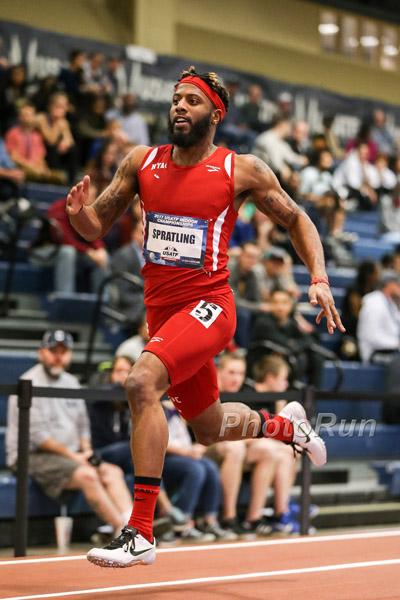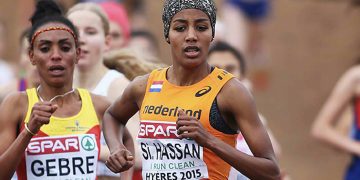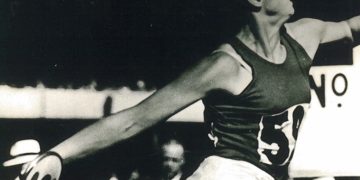 Brycen Spratling, photo by PhotoRun.net
Brycen Spratling, photo by PhotoRun.net
David Hunter focused his pen on Brycen Spratling in the middle of March. Brycen, a very talented long sprinter, is trying to decide on what his event truly is: the 400 meters or the 800 meters. As he tests the 800 meters, we could see another fast 800 meter runner in the mix in the U.S.
Watch for David Hunter’s next piece next week! And watch for David to join me covering the 2017 Boston Marathon as we do each year.
March 16th , 2017
Back in the late ’60’s, Martin McGrady – a terrific middle distance racer – dominated the indoor scene. His specialty was the frenetic 600 yard run – an event upon which he was virtually untouchable on those creaky 160 yard banked wooden tracks. Dominating the likes of Olympic 400m champion and world record holder Lee Evans and every other middle distance great, McGrady was a 3-time indoor national champion and 3-time Millrose Games winner. In 1970, he set the indoor 600 yard world record of 1:07.6 – a global best that endured for 22 years. With all due respect to my friend Eamonn Coughlan, McGrady was the original, the authentic “Chairman of the Boards.” Superior at the indoor Imperial distance, McGrady could never find his groove in an outdoor, metric Olympic distance event. Unable to transform his indoor success to the big outdoor oval, McGrady has been relegated to the footnotes of track & field.
Memories of McGrady are evoked by watching the speed, the grace, the talent, and the indoor superiority of middle distance performer Brycen Spratling. Two years ago, Spratling flashed around the Armory’s 200 meter oval to win the Millrose Games 500 meter race in a world best time of 1:00.06. Several months later – as part of a USA quartet – the long sprinter ran the 400m leg on a world-record setting distance medley relay team. Yet like McGrady a generation ago, the two-time world record holder is still searching to find the outdoor event that is right for him.
On the big oval outdoors, Brycen Spratling races over 400 meters. A 10-time All-American while at Pitt, the young athlete has an outdoor personal best of 45.09. 2016 was a year of outdoor challenges for Spratling. At the U.S. Olympic Trials, he failed to advance past the semi-final round of the 400 meters. And at year end, he was unranked among the nation’s top ten 400 meter athletes as assembled by Track & Field News.
Here’s the rub: as accomplished as Spratling is as an indoor long sprint competitor, he comes up just tantalizingly shy of that breakthrough outdoor sub-45 second 400 meter clocking that would transform him from a USA finalist to a genuine podium honoree. “I honestly think that I can run 44 seconds,” reveals Spratling, who acknowledges that a PR improvement of just .25-.35 seconds in the 400 could lift him up into the elite USA tier. “I don’t think that it is anything too crazy to ask of myself to do – or anything like that. I think I’m right there. I think it comes down to a couple of race pattern things.” But then the former Pitt star offers this observation. “Just knowing that I think I can run 44 seconds makes me think that I could be a deadly 800 meter runner, just with that kind of speed.”
The 25-year-old Spratling declares that a possible experimentation over 800 meters is not sparked by any sense of frustration with his 400 meter performances. Having thought about moving up for some period of time, the quarter miler admits it took him a while to summon up the bravery to undertake the longer event. “I just needed time to just build up the courage to want to go out there and do it,” explains Spratling. “I’ve run a few 800’s and it’s always been fun. But I’ve never run one with any kind of 800 meter training at all,” he confesses. “I guess it all started when I was forced to run on the 4 by 8 in high school and I split 1:52. And I didn’t have any training for anything at that point, really,” he laughs.
Spratling’s performances in longer indoor races have boosted his confidence about his potential at 800 meters. “Honestly, for running the 800, I know I can keep up for at least 650 meters. At that point, it’s just determination, just holding on,” offers Spratling, one of the elite track & field athletes representing the New York Athletic Club. “The one thing that gives me a lot of confidence is I know that no one is going to run away from me in that first 500-600 meters. And then I know I’m in the race. If I can take it serious enough and be in the race coming down to the last 200 meters, the last 150 – and if I still have a kick left – I don’t think anyone is going to outkick me in the last 150. That’s how I look at it.”
The young professional is serious about moving up and is planning to race at 800 meters this upcoming outdoor season. Spratling has conferred with his coach – Pitt’s head coach Alonzo Webb – who is supportive of Spratling’s intended exploration of the longer distance. “[Coach Webb] is on board with whatever I want to do. He ultimately thinks I can be great at either one. I don’t think he thinks it is a big separation between either one. He thinks whichever one I put my mind to, I can be pretty good.” Spratling’s excitement is readily observable as he contemplates his upcoming Alberto Juantorena-like experiment. “I honestly believe I could be a great 800 meter runner and also a great 400 meter runner, depending upon my training and everything.”
Ironically – and perhaps adding a dash of confusion to the choices Spratling faces – the long sprinter’s notable progression during the just-completed indoor season suggests an outdoor breakthrough at the shorter 400 meter distance might be just around the corner. Mid-season, Spratling ran a 300 meter indoor PR [33.05]. Although overshadowed by Noah Lyles and his indoor 300 meter world record to capture the USATF indoor 300m title, Spratling won the first section of the 300 meter timed final in 32.63 – yet another big personal best.
Early outdoor planning has Spratling opening up with a 400 meter race at the Florida Relays followed by a low-key 800 meter race below the radar. “I will look at the team schedule at Pitt and see where they’re going. It will probably be a real low-key meet – maybe get a rabbit out there to just pull me through and see what I can run. But I don’t think it will be anything that people will be looking out for, or anything like that.”
Spratling knows the trick is to develop a training pathway that, once followed, allows him to acquire increased strength and endurance while not losing his current superior footspeed. “I think that I feel like my footspeed is there. It’s established. My body is used to it: going out there and running fast. I also don’t think that it would be that hard for me to build up the endurance when I am already good for 600 meters. I also don’t think it would be that much of a stretch to get up to that endurance level to just finish an 800,” explains the NYAC long sprinter. “I feel like it would be a lot easier for me to build up that endurance, then for me to be someone trying to build up footspeed.”
Spratling also understands that another essential component of a thoughtfully-assembled plan would be increased weekly mileage. “I’m not really sure about weekly mileage. I honestly never really kept track. This year I’ve upped it, though. On the weekends I do 30 minutes and 45 minutes. So it’s a little bit more endurance than I have ever had,” notes the would-be 800 meter runner. “There’ll probably be a discussion with my coach about how we want to go about training for [the 800 meters]. I know that I would have to put a lot more work in to run the 800.” But Brycen Spratling is willing to go the extra mile – especially if it helps him go the extra lap. Dave Hunter
Author

Dave Hunter is an award-winning journalist who is a U.S. Correspondent for Track & Field News. He also writes a weekly column and serves as Senior Writer for www.RunBlogRun.com, and covers championship track & field competition domestically and in such global capitals as Moscow, Birmingham, Zurich, Brussels, Beijing, Rio de Janeiro, Zagreb, Ostrava, and Doha. Hunter frequently serves as the arena or stadium announcer for championship track & field gatherings, including the Ivy League, the Big East, the Mid-American Conference, the NAIA, the Big Ten, and the Millrose Games. Hunter has undertaken foreign and domestic broadcast assignments. He ran his marathon P.R. 2:31:40 on the Boston Marathon course back in the Paleozoic Era. To find out more about Dave, visit his website: www.trackandfieldhunter.com He can be reached at: dave@trackandfieldhunter.com
View all posts




















